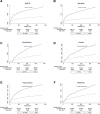Peripheral artery disease and outcomes in patients with acute myocardial infarction
- PMID: 31245013
- PMCID: PMC6560667
- DOI: 10.1136/openhrt-2018-001004
Peripheral artery disease and outcomes in patients with acute myocardial infarction
Abstract
Aim: To describe the population of patients with previously diagnosed peripheral artery disease (PAD) experiencing a myocardial infarction (MI) and to investigate 1-year major adverse cardiac events (MACE: all-cause mortality, reinfarction, stroke and heart failure hospitalisation) following MI.
Background: MI patients with PAD constitute a high-risk population with adverse cardiac outcomes. Contemporary real-life data regarding the clinical characteristics of this patient population and clinical event rates following MI remain scarce.
Methods: This observational study included all MI patients presenting with ST-elevation MI or non-ST-elevation MI between 01 January 2005 and 31 December 2014 with (n=4213) and without (n=106 763) a concurrent PAD diagnosis, identified in the nationwide Swedish Web-system for Enhancement and Development of Evidence-based care in Heart disease Evaluated According to Recommended Therapies registry and the National Patient Registry (PAD prevalence: 3.8%). Cox proportional hazard models were applied to compare the outcome between the two populations.
Results: MI patients with PAD were older and more often burdened with comorbidities, such as diabetes, hypertension and previous MI. After adjustments, PAD was significantly associated with higher rates of MACE (HR 1.35, 95% CI 1.27 to 1.44), mortality (HR 1.59, 95% CI 1.43 to 1.76), reinfarction (HR 1.48, 95% CI 1.32 to 1.66), stroke (HR 1.27, 95% CI 1.05 to 1.53), heart failure (HR 1.29, 95% CI 1.20 to 1.40) and bleeding (HR 1.26, 95% CI 1.09 to 1.47) at 1 year.
Conclusion: A concurrent PAD diagnosis was independently significantly associated with higher rates of adverse outcomes following MI in a nationwide real-life MI population. The low prevalence of PAD compared with previous studies suggests significant underdiagnosing. Future studies should investigate if PAD screening with ankle-brachial index may increase diagnosing and subsequently lead to improved treatment of polyvascular disease.
Keywords: epidemiology; myocardial infarction; peripheral artery disease.
Conflict of interest statement
Competing interests: None declared.
Figures

Similar articles
-
The impact of peripheral artery disease on major adverse cardiovascular events following myocardial infarction.Int J Cardiol. 2021 Nov 15;343:131-137. doi: 10.1016/j.ijcard.2021.08.053. Epub 2021 Sep 6. Int J Cardiol. 2021. PMID: 34499974
-
Peripheral artery disease and outcomes after myocardial infarction: an individual-patient meta-analysis of 28,771 patients in CAPRICORN, EPEHESUS, OPTIMAAL and VALIANT.Int J Cardiol. 2013 Sep 30;168(2):1094-101. doi: 10.1016/j.ijcard.2012.11.033. Epub 2012 Nov 26. Int J Cardiol. 2013. PMID: 23194780
-
Temporal trends in characteristics and outcomes after myocardial infarction in patients with and without peripheral artery disease - A Nationwide, register-based follow-up study.Int J Cardiol. 2024 Apr 15;401:131812. doi: 10.1016/j.ijcard.2024.131812. Epub 2024 Jan 26. Int J Cardiol. 2024. PMID: 38280530
-
Morbidity and mortality associated with atherosclerotic peripheral artery disease: A systematic review.Atherosclerosis. 2020 Jan;293:94-100. doi: 10.1016/j.atherosclerosis.2019.09.012. Epub 2019 Sep 24. Atherosclerosis. 2020. PMID: 31606132
-
Peripheral Artery Disease and COVID-19 Outcomes: Insights from the Yale DOM-CovX Registry.Curr Probl Cardiol. 2022 Dec;47(12):101007. doi: 10.1016/j.cpcardiol.2021.101007. Epub 2021 Oct 7. Curr Probl Cardiol. 2022. PMID: 34627824 Free PMC article. Review.
Cited by
-
Nutritional Advantages of Walnut (Juglans regia L.) for Cardiovascular Diseases: A Comprehensive Review.Food Sci Nutr. 2024 Dec 30;13(1):e4526. doi: 10.1002/fsn3.4526. eCollection 2025 Jan. Food Sci Nutr. 2024. PMID: 39803290 Free PMC article. Review.
-
Clinical outcome after bleeding events following coronary stenting in patients with and without comorbid peripheral arterial disease.Cardiovasc Interv Ther. 2025 Apr;40(2):287-295. doi: 10.1007/s12928-024-01073-7. Epub 2024 Dec 19. Cardiovasc Interv Ther. 2025. PMID: 39699832 Clinical Trial.
-
Ischemic cardio-cerebrovascular disease and all-cause mortality in Chinese elderly patients: a propensity-score matching study.Eur J Med Res. 2024 Jun 15;29(1):330. doi: 10.1186/s40001-024-01929-x. Eur J Med Res. 2024. PMID: 38879523 Free PMC article.
-
Construction and Validation of a Predictive Model for Long-Term Major Adverse Cardiovascular Events in Patients with Acute Myocardial Infarction.Clin Interv Aging. 2024 Nov 26;19:1965-1977. doi: 10.2147/CIA.S486839. eCollection 2024. Clin Interv Aging. 2024. PMID: 39619631 Free PMC article.
-
Temporal Trends and Mortality Patterns in Peripheral Arterial Disease: A Comprehensive Analysis of Hospitalized Patients in Kazakhstan between 2014 and 2021.J Epidemiol Glob Health. 2024 Dec;14(4):1609-1618. doi: 10.1007/s44197-024-00313-6. Epub 2024 Oct 14. J Epidemiol Glob Health. 2024. PMID: 39400655 Free PMC article.
References
-
- Beckman JA, Preis O, Ridker PM, et al. . Comparison of usefulness of inflammatory markers in patients with versus without peripheral arterial disease in predicting adverse cardiovascular outcomes (myocardial infarction, stroke, and death). Am J Cardiol 2005;96:1374–8. 10.1016/j.amjcard.2005.07.041 - DOI - PubMed
Publication types
LinkOut - more resources
Full Text Sources
Medical
